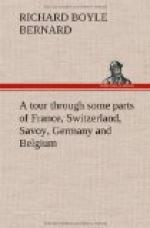The canton of Schweitz, which, at present, gives name generally to the whole confederation of cantons, is said to have been first inhabited by some persons forced to quit Sweden by religious differences. The union of this canton to those of Uri and Unterwald, first suggested that more extended confederacy, so essential to the existence of these diminutive states.
Here the Roman Catholic is the only religion tolerated, but intolerance in Switzerland is not peculiar to the Roman Catholic cantons, as in some, Calvinism only is permitted. At Brunnen I met some persons going on a pilgrimage to the shrine of Notre Dame des Ermites, at Einsiedlen, one of whom was a Frenchman, decorated with the Lys. It would be well for the Bourbons if all their subjects were possessed of but a small part of the loyalty which this gentleman expressed for them. Brunnen is a large and handsome town, situated on the lake; it was here that the cantons of Schweitz, Uri, and Unterwald, concluded their perpetual alliance. Altorf is the capital of the canton of Uri, it contains many handsome houses, and here is the statue of William Tell, in the place where he was condemned to shoot the arrow at his son. The cattle in this Canton, as well as in Schweitz, are large and handsome. I was told that many of their favourite cows had silver bells fastened round their necks. The horses are also provided with tails of a large size, the noise of which I thought extremely unpleasant, although often obliged to listen to it for many hours together. Stantz is the chief town of Unterwald, but is only remarkable for its being prettily situated. In the three original cantons, every citizen on attaining the age of sixteen, has the right of suffrage in the General Assemblies. On my return to Lucerne from this excursion, it appeared more gloomy than ever, and I determined on quitting it next morning for Zug. The Pope’s nuncio resides in this town, as being the capital of the chief Roman Catholic canton, and I observed sentinels at his door, although there were none at the gates of the city. Lucerne was, under the French system, the seat of the general government of Switzerland, now removed to Zurich. The canton of Lucerne is, in general, well cultivated, and contains not less than 100,000 inhabitants. Between Lucerne and Zug, I observed a number of peasants practising with the ancient weapons of William Tell, which they appeared to use with great dexterity.




